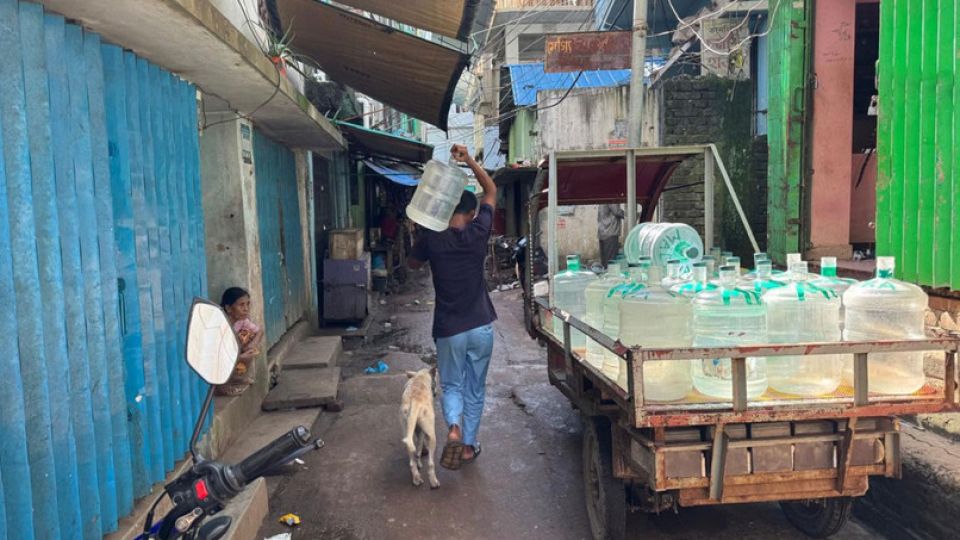November 18, 2025
DHAKA – Groundwater levels are depleting rapidly across almost all upazilas in Cox’s Bazar, raising fears of an acute water crisis in the near future.
According to the Department of Public Health Engineering, the situation is most severe in Cox’s Bazar municipality, Ukhiya, and Teknaf.
Uncontrolled extraction and unplanned management have caused groundwater levels in Cox’s Bazar municipality to drop by 6–14 feet annually, says a DPHE report. In areas like Kolatoli and Tekpara, water is now found at depths of 90–110 feet.
Severe water shortages persist in Wards 3, 4, 5, and 6 of the municipality. Many residents are forced to collect water from distant areas or buy it. Tube-well water has high salinity and is suitable only for bathing and household chores, while residents complain that water supplied by the municipality is of poor quality and has a foul smell.
DPHE officials estimate that around 30,000 deep and shallow tube-wells are operational across the district.
Usain Chi, 60, of Boro Bazar, said, “After the 1991 cyclone, the groundwater here became saline, and it has worsened since then. Finding fresh water is now our biggest challenge.”
Mang Su Prue, owner of a five-storey building in the same area, said, “Even after drilling 400 feet deep, I couldn’t find fresh water. The municipal water supply smells bad and isn’t fit for drinking.”
The situation in Ukhiya and Teknaf, near the Rohingya camps, is even more alarming due to excessive extraction. In parts of Rajapalong and Palongkhali unions of Ukhiya, water is now found at depths of 100–110 feet, dropping 8–14 feet annually, said Md Ibne Mayaz Pramanik, executive engineer of DPHE in Cox’s Bazar.
Water is now found at 40–60 feet in Jhilongja and Bharuakhali in Sadar upazila, 25–45 feet in Eidgaon, 20–28 feet in Ramu, 20–40 feet in Chakaria, and 12–40 feet in Pekua, with annual declines averaging 2–5 feet.
Mayaz said although there are no permanent observation wells yet, 28 monitoring wells have been installed in Ukhiya and Teknaf under the World Bank-supported EMCRP project.
In addition, 32 mini-pipe schemes are being equipped with real-time data loggers to provide regular data from the next dry season. A groundwater monitoring project is also underway in Cox’s Bazar, Ukhiya, and Teknaf with support from Dhaka University and Unicef.
“Effective steps, including rainwater harvesting, increased use of surface water, and groundwater recharge initiatives, are needed urgently to prevent future crisis,” he warned.
Due to the alarming depletion, Cox’s Bazar’s water supply system is under severe strain.
Rubel Barua, assistant engineer of the municipality, said, “Our nine pump houses were set up in 2011–12. Since then, the water table has kept falling. Earlier we could find water at 150–200 feet, but now even at 1,200–1,500 feet it’s difficult.”
“The water we get is of poor quality, foul-smelling, and unfit for use. Most private tube-wells no longer work, which puts strain on municipal supply. We’re now trying to supply water twice a day from the few pumps that still work,” he said.
As a long-term solution, the municipality is turning to surface water treatment.
“The surface water treatment plant on the Bankkhali river will become the main source of safe water in future. Its commissioning work is underway and it’s expected to be fully operational by late December or early January,” said Barua.
Abul Mansur, assistant engineer of DPHE in Cox’s Bazar, said the plant would be able to treat around 10 lakh litres of water hourly.
“We hope that once it becomes operational, it alone can meet up to 55 percent of the municipality’s water demand,” he added.


